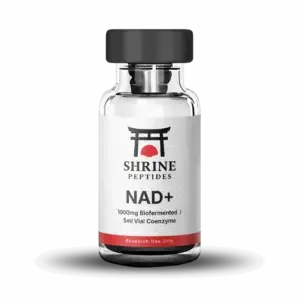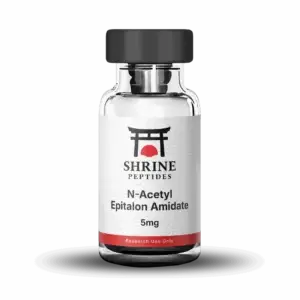Epithalon (10mg)
$92.00
Epithalon (10mg) – Research grade peptide for laboratory investigations and preclinical studies | Research Use Only – Not for Human Consumption
Epithalon (10mg) Research Compound
Research Use Only – Not for Human or Animal Consumption
Epithalon (10mg) is a synthetic research peptide that has been investigated in laboratory settings for its potential interactions with various biological pathways. This research compound has been studied in preclinical models to evaluate its pharmacological properties and potential mechanisms of action.1 Preliminary investigations have examined this peptide’s effects on cellular signaling pathways, receptor interactions, and physiological responses in controlled laboratory environments.
Research Overview
Laboratory studies have explored the potential biological activities of Epithalon (10mg) through various experimental methodologies. Research has focused on characterizing the peptide’s structure-activity relationships, binding affinities to target receptors, and downstream signaling cascade activation.2 Preclinical investigations have utilized multiple research models to assess the compound’s pharmacokinetic properties, including absorption, distribution, metabolism, and elimination characteristics. These fundamental research efforts contribute to the broader understanding of peptide-based signaling mechanisms and their potential applications in biological research.
Preclinical Investigations
Research teams have conducted systematic investigations to evaluate Epithalon (10mg)’s biological activities in controlled experimental settings. Studies have employed various in vitro and in vivo methodologies to assess the peptide’s effects on cellular processes, tissue function, and systemic responses in research models.3 Data from these investigations have contributed to understanding the peptide’s potential mechanisms of action, optimal dosing parameters for research applications, and potential interactions with biological systems.
Product Specifications
- Contents: Epithalon (10mg)
- Form: Lyophilized powder
- Purity: >98% (verified by HPLC)
- Storage: Store at -20°C in a dry environment
- Reconstitution: Use bacteriostatic water for laboratory applications
- Stability: Stable when stored properly under recommended conditions
Quality Assurance and Documentation
- Third-party laboratory tested for purity and identity verification
- Certificate of Analysis (COA) available upon request for each batch
- HPLC chromatography results provided
- Mass spectrometry data available
- Manufactured under strict quality control protocols
- Batch-specific documentation and traceability
- Compliance with research-grade standards
Research Applications
- Peptide receptor interaction studies
- Cellular signaling pathway research
- Pharmacokinetic and pharmacodynamic investigations
- Structure-activity relationship studies
- Preclinical model research
- Biochemical pathway mapping
- Molecular mechanism elucidation
- In vitro biological activity screening
- Peptide stability and formulation research
- Comparative peptide pharmacology studies
Important Research Notice
FOR LABORATORY AND RESEARCH USE ONLY. This product is intended exclusively for scientific research, in vitro studies, and laboratory investigations. This compound is not intended for human or animal consumption, clinical applications, or any diagnostic or therapeutic uses.
Researchers should consult relevant scientific literature and follow appropriate safety protocols when handling this research compound. Proper laboratory equipment, personal protective equipment, and training are required for working with this material.
Regulatory Compliance Statement
This product is sold as a research chemical for laboratory use only. Shrine Peptides operates as a chemical supplier. Shrine Peptides is not a compounding pharmacy or chemical compounding facility as defined under 503A of the Federal Food, Drug, and Cosmetic Act. Shrine Peptides is not an outsourcing facility as defined under 503B of the Federal Food, Drug, and Cosmetic Act.
The statements made within this product description have not been evaluated by the US Food and Drug Administration. The products we offer are not intended to diagnose, treat, cure or prevent any disease. Human/Animal Consumption Prohibited. Laboratory/In-Vitro Experimental Use Only.
Please review and adhere to our Terms and Conditions before ordering.
References:
- Khavinson VKh. Peptides and Ageing. Neuro Endocrinol Lett. 2002;23 Suppl 3:11-144. PMID: 12374906. https://pubmed.ncbi.nlm.nih.gov/12374906/
- Khavinson, Vladimir et al. “AEDG Peptide (Epithalon) Stimulates Gene Expression and Protein Synthesis during Neurogenesis: Possible Epigenetic Mechanism.” Molecules (Basel, Switzerland) vol. 25,3 609. 30 Jan. 2020, doi:10.3390/molecules25030609. https://www.ncbi.nlm.nih.gov/pmc/articles/PMC7037223/
- Anisimov VN, Mylnikov SV, Khavinson VK. Pineal peptide preparation epithalamin increases the lifespan of fruit flies, mice and rats. Mech Ageing Dev. 1998 Jun 15;103(2):123-32. doi: 10.1016/s0047-6374(98)00034-7. PMID: 9701766.
- Yue X, Liu SL, Guo JN, Meng TG, Zhang XR, Li HX, Song CY, Wang ZB, Schatten H, Sun QY, Guo XP. Epithalon protects against post-ovulatory aging-related damage of mouse oocytes in vitro. Aging (Albany NY). 2022 Apr 12;14(7):3191-3202. doi: 10.18632/aging.204007. Epub 2022 Apr 12. PMID: 35413689; PMCID: PMC9037278.
- Lin’kova, N.S., Drobintseva, A.O., Orlova, O.A. et al. Peptide Regulation of Skin Fibroblast Functions during Their Aging In Vitro . Bull Exp Biol Med 161, 175–178 (2016).
- Khavinson VKh, Bondarev IE, Butyugov AA, Smirnova TD. Peptide promotes overcoming of the division limit in human somatic cell. Bull Exp Biol Med. 2004 May;137(5):503-6. doi: 10.1023/b:bebm.0000038164.49947.8c. PMID: 15455129. https://pubmed.ncbi.nlm.nih.gov/15455129/
- Khavinson VKh, Lezhava TA, Monaselidze JR, Jokhadze TA, Dvalishvili NA, Bablishvili NK, Trofimova SV. Peptide Epithalon activates chromatin at the old age. Neuro Endocrinol Lett. 2003 Oct;24(5):329-33. PMID: 14647006. https://pubmed.ncbi.nlm.nih.gov/14647006/
- Rosenfeld SV, Togo EF, Mikheev VS, Popovich IG, Khavinson VKh, Anisimov VN. Effect of Epithalon on the incidence of chromosome aberrations in senescence-accelerated mice. Bull Exp Biol Med. 2002 Mar;133(3):274-6. doi: 10.1023/a:1015899003974. PMID: 12360351. https://pubmed.ncbi.nlm.nih.gov/12360351/
- Kossoy G, Anisimov VN, Ben-Hur H, Kossoy N, Zusman I. Effect of the synthetic pineal peptide Epithalon on spontaneous carcinogenesis in female C3H/He mice. In Vivo. 2006 Mar-Apr;20(2):253-7. PMID: 16634527. https://pubmed.ncbi.nlm.nih.gov/16634527/
- Pateyk AV, Baranchugova LM, Rusaeva NS, Obydenko VI, Kuznik BI. Effect of peptides Lys-Glu-Asp-Gly and Ala-Glu-Asp-Gly on the morphology of the thymus in hypophysectomized young and old birds. Bull Exp Biol Med. 2013 Mar;154(5):681-5. doi: 10.1007/s10517-013-2029-0. PMID: 23658898. https://pubmed.ncbi.nlm.nih.gov/23658898/
- Korkushko OV, Lapin BA, Goncharova ND, Khavinson VKh, Shatilo VB, Vengerin AA, Antoniuk-Shcheglova IA, Magdich LV. [Normalizing effect of the pineal gland peptides on the daily melatonin rhythm in old monkeys and elderly people]. Adv Gerontol. 2007;20(1):74-85. Russian
- Khavinson V, Razumovsky M, Trofimova S, Grigorian R, Razumovskaya A. Pineal-regulating tetrapeptide Epithalon improves eye retina condition in retinitis pigmentosa. Neuro Endocrinol Lett. 2002 Aug;23(4):365-8. PMID: 12195242. https://pubmed.ncbi.nlm.nih.gov/12195242/
- Khavinson VKh, Morozov VG. Geroprotektornaia éffektivnost’ timalina i épitalamina [Geroprotective effect of thymalin and Epithalamin]. Adv Gerontol. 2002;10:74-84. Russian. PMID: 12577695. https://pubmed.ncbi.nlm.nih.gov/12577695/
- Korkushko OV, Khavinson VKh, Shatilo VB, Antonyuk-Shcheglova IA. Geroprotective effect of Epithalamine (pineal gland peptide preparation) in elderly subjects with accelerated aging. Bull Exp Biol Med. 2006 Sep;142(3):356-9. English, Russian. doi: 10.1007/s10517-006-0365-z. PMID: 17426848. https://pubmed.ncbi.nlm.nih.gov/17426848/








Reviews
There are no reviews yet.